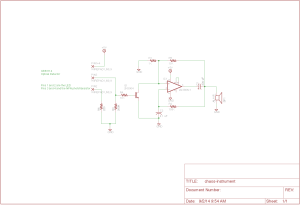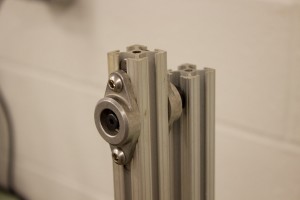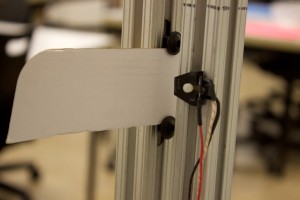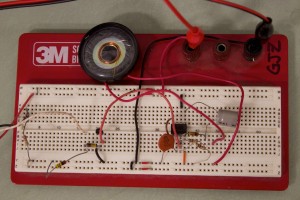1A – Basic Circuits Project – Chaos Instrument (Example Graded Project)
|
(This post can serve as a basic template for a post on graded student work. These posts should follow the guidelines detailed under Grading Rubric in the syllabus. These posts must be assigned to the “Graded Projects” category.)
Group Members: Garth Zeglin IntroductionI set out to answer the question, “what is the sound of chaos?” This is answered using the movement of a physical double pendulum, sensed with a photoreflector and used to control the pitch of an audio oscillator driving a speaker. This forms a kind of chaotic metronome with erratic beats, settling into a recognizable but subtly varying tempo as the faster modes dissipate away. A double pendulum is the simplest example of a chaotic dynamic system. It produces complex motions which are very sensitive to initial conditions and thus hard to predict, even though the actual physics is well-understood and the differential equations describing the motion are not complex. Considered as a “one-in-one-out” system, the input is the human touch activating the pendulum, and the output is the audible sound. The system includes both the pendulum as a physical oscillator and an LM386 electronic oscillator to generate the sound. Since the sound does not meaningfully affect the pendulum motion, it is strictly a pipeline from physical motion to electrical representation back to a physical sound. Videonote: the embedded video above is 960px wide because our website’s content is 960px wide
Technical NotesThe pendulum is made from 80/20 aluminum extrusion pivoted on ball bearings. The ball bearings have low friction and are essential for allowing the dynamics to emerge, otherwise the motion would quickly damp out. The axles are 0.250 inch diameter shoulder screws. The bearings are held in place along the shaft using commercially available bearing blocks. The only machining required was four cross-holes, two for shaft clearance between the bearings and two for a tight fit on the stationery axle end. The pendulum must be clamped firmly to a table. PhotosNote: These pictures were uploaded to Google’s Picasa service, and embedded in this post as a slideshow; the slideshow maintains the site’s 960px width. If someone searches the web and comes across these pictures in an image search, they will be directed to Picasa, not to this site. Note that the Picasa slideshow requires Flash. |




